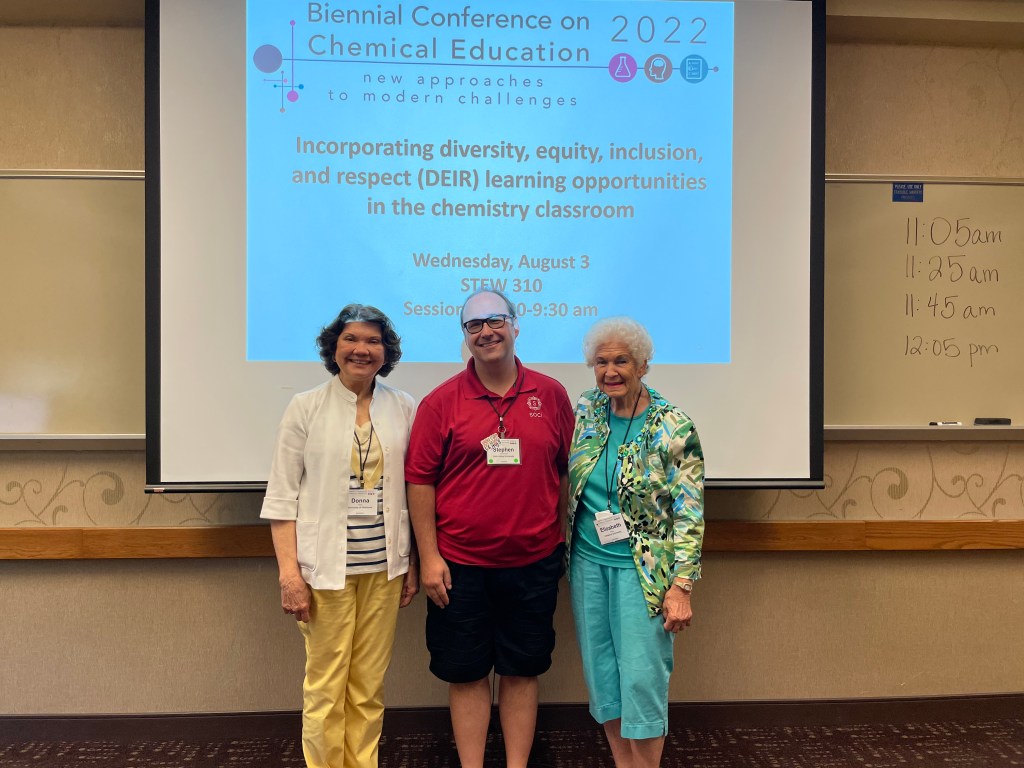Greetings readers,
Wow, what a conference! Because COVID forced the organizing committee to cancel the 2020 meeting, this is the first BCCE held since we met at the University of Notre Dame in 2018. Yet we found ourselves back in the sweltering summer humidity of Indiana, this time at Purdue University.
Because the conference welcomes chemistry instructors from all types of colleges as well as high school, one will get the most out of their experience if they attend the conference with a specific focus. I had two, and I also gave a talk that described my approach to diversity and inclusion. My first objective was to learn how to evaluate student learning more effectively. Not only do I hope to help each individual identify specifically what he or she needs to work on, but if I grade effectively I’ll also know what the students are learning collectively. My second objective was to learn how I can make my teaching as inclusive and accessible as possible.
Probably the highlight of my conference was a day-long workshop where I worked with several colleagues to develop a comprehensive rubric to grade mechanism problems in organic chemistry. A rubric is helpful not just for instructors to use as they prepare a grading key, but is essential for students. By identifying areas of emphasis and assigning points along a spectrum of thinking that aligns with currently accepted practices for drawing mechanisms, we set clear expectations that students can use to adjust their study and preparation. Led by Dr. Jay Wackerly of Central College (IA), Dr. Sarah Zingales of the University of St. Joseph (CT), and Dr. Michael Wentzel of Augsburg University (MN), workshop attendees identified a series of evaluation criteria that serve as a launchpad for us to further refine and develop a personal rubric that we will use and share with colleagues at our home institutions. The four key criteria we developed are: Proper arrows, Structural integrity, Reagent usage, and Rationality of Steps. As I modify these categories into my own rubric, I think a fifth category should be added to evaluate stereochemistry, regiochemistry, and chemoselectivity where appropriate. Each of these criteria would be judged along a continuum that ranges from Mastery (perfect) to Developing (some correct ideas manifested as one or more minor or major errors) to Emerging (a soupçon of ideas that align with learning goals but which lacks clear understanding). Thus, a student reviewing his or her graded problem can know confidently exactly which general areas are solid and which need work. This approach is helpful as a teacher because students so often focus on where they lost points. Our goal, of course, is not to encourage or reward memorization but to inculcate deep, process-oriented thinking and problem-solving ability. An added bonus is that such a rubric could be used during carefully structured Calibrated Peer Grading exercises where students evaluate each other’s work. This would most likely be done as practice leading up to major exams where students would be expected to propose reasonable reaction mechanisms.
Learning ways to recognize and foster diversity and inclusion in my courses was another key area of engagement for me at the conference. I attended workshops that described Universal Design for Learning (UDL), diversity and inclusion, and inclusive course design, which prepares us to structure our courses in ways likely to increase success for students who identify as PEERs, or Persons Excluded on the basis of Ethnicity or Race.
In my talk, I described how I created and deploy an in-class group activity that highlights the work of a female synthetic organic chemist. An added bonus of attending the session on Diversity, Equity, Inclusion, and Respect (DEIR) was that I had the fortune to meet two of my heroes in Chemistry, Dr. Donna Nelson and Dr. Ann Nalley.

I’m already planning to attend the 2024 BCCE, which will be held at the University of Kentucky.
